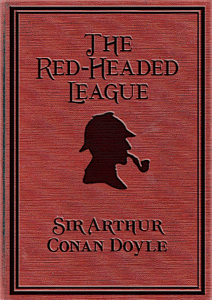
A Year: Day to Day Men: 1st of December
The Painted Wall
December 1, 1887 marks the first appearance of Sherlock Holmes in print.
The first appearance of Sherlock Holmes was in the detective novel “A Study in Scarlet” written by British author Sir Arthur Conan Doyle. It appeared in the magazine “Beeton’s Christmas Annual” on December 1st of 1887,  published by Ward Lock and Company of London. Although Sir Conan Doyle wrote fifty-six short stories featuring Holmes, “A Study in Scarlet” is one of only four full-length novels in the original canon.
published by Ward Lock and Company of London. Although Sir Conan Doyle wrote fifty-six short stories featuring Holmes, “A Study in Scarlet” is one of only four full-length novels in the original canon.
Sir Conan Doyle, a general practice doctor, wrote “A Study in Scarlet” at the age of twenty-seven in less than three weeks. The novel was originally entitled “A Tangled Skein” but changed for publication in the Christmas Annual. Doyle received twenty-five pounds for the novel, but no royalties.
“A Study in Scarlet” begins with a heading which establishes the role of Dr. John Watson as narrator, setting up the point that the work to follow is not fiction but fact, being a reminiscence of Dr. Watson. The novel  introduces Holmes to Watson, establishes their friendship, and brings in the character of Inspector Lestrade. It is also the first work of detective fiction to incorporate the magnifying glass as an investigative tool.
introduces Holmes to Watson, establishes their friendship, and brings in the character of Inspector Lestrade. It is also the first work of detective fiction to incorporate the magnifying glass as an investigative tool.
There are only eleven complete copies of the 1887 “Beeton’s Christmas Annual” known to exist; each now having considerable value. Ward Lock and Company published “A Study in Scarlet in a book form in July of 1888 with featured illustrations by Charles Doyle, Conan’s father. A second edition was published in the following year, this time illustrated by George Hutchinson. In 1890 the first American version was published by Philadelphia-based J.B. Lippincott and Company.
As the first Sherlock Holmes story published, “A Study in Scarlet” was among the first to be adapted to the screen. In 1914, Conan Doyle authorized a silent film to be produced by G. B. Samuelson. Holmes was played by James Bragington, an accountant who worked as an actor for the only time of his life. He was hired for his resemblance to Holmes, as presented in the sketches originally published with the story. Due to the nature of film at that time and the rarity of archiving, it is now a lost film. The success of the film allowed for a second version to be produced that same year by Francis Ford, which has also been lost.
for his resemblance to Holmes, as presented in the sketches originally published with the story. Due to the nature of film at that time and the rarity of archiving, it is now a lost film. The success of the film allowed for a second version to be produced that same year by Francis Ford, which has also been lost.
The novel “A Study in Scarlet” has rarely been adapted in full: the 1933 film entitled “A Study in Scarlet” with Reginald Owen actually bears no plot relation to the novel. The most notable instance closest to the novel is the episode in the second season of the BBC television series “Sherlock Holmes” with Peter Cushing as Holmes and Nigel Stock as Dr. Watson, which put more detail into the screenplay.
Bottom Insert Image: Sidney Paget, “Holmes Gives Me a Sketch of the Events”, 1892, Illustration for “Silver Blaze”, Strand Magazine, December, 1892, Private Collection